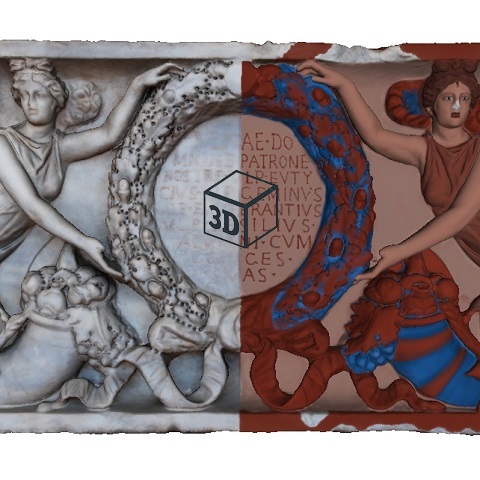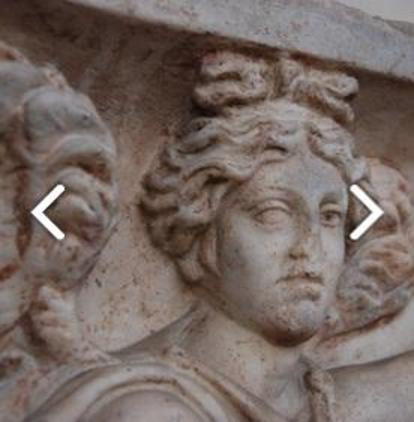Aim of the pilot project
The aim of this project is to identify both the pigments and the techniques of application used on the Ulpia Domnina's sarcophagus (Museo Nazionale Romano - Terme di Diocleziano, inv. no. 125891), and to explore the potential of emerging technologies in the reconstruction and visualization of the ancient colour.
Case-study
The test activity has been carried out on the polychrome sarcophagus dedicated by four freedmen and their wives to their deceased patron Ulpia Domnina. It is made of Preconnesian marble in Rome and it was generally dated in the academic literature at the late 2nd or early 3rd centuries A.D.
The sarcophagus was found in 1953 in Rome during the construction of a building. It is a mass-production sarcophagus with Victories holding a shield and funerary Cupids that was chosen mainly because of the fair state of preservation of its original polychromy, which could have potentially shed light on the colouring techniques used.
Methodology and testing activity
Using an interdisciplinary approach that has utilized some emergent technologies as linking bridge between archaeological and scientific data, we identified the nature of the pigments used to paint the Ulpia Domnina’s sarcophagus and the different techniques utilized for their application.
In particular, from historical and iconographic researches, the careful observations with optical professional devices and the results of scientific analyses (multispectral and infrared imaging, Raman spectroscopy and especially the optical petrographic microscopy), we found that this sarcophagus was coloured in two different moments of the antiquity.
The original colouring was applied in the late 2nd century (160-180 AD) when the sarcophagus was made; while the secondary painting probably came from a repainting of the mid-3rd century AD, when the inscription to Ulpia Domnina was recarved lowering the original level of the background.
Starting from this achieved data, we also tested the potentialities of two open source tools (MeshLab and Blender), both to create a scientific reconstruction of ancient polychromy and to return out the realistic renderings of the colour considering the light effects.
3D model and reconstruction of ancient polychromy
The sarcophagus was digitized using a 3D scanning system based on geometric triangulation; sampled 3D data were processed to produce a high-resolution 3D model using MeshLab, an open source mesh processing system developed by Visual Computing Lab of ISTI-CNR.
In parallel, reference values for the original colours have been sampled with some high-resolution and calibrated images of the representative areas, acquired on Ulpia Domnina's sarcophagus by using a DSLR camera with a colour calibration table (a Mini Macbeth Colorchecker™). From the images, colour-corrected using the known colours on the chart, the RGB coordinates of the selected coloured traces were derived.
The current colour and the reconstruction of the hypothesis of the secondary polychromy was applied to the digital 3D model using the paint tool of MeshLab.
3DHOP viewer
Clicking on the image below you can visualize, in interactive way, the geometrical 3D model and switch from current colour for original colouring proposal of Roman sarcophagus.

Publications
E. Siotto, M. Callieri, M. Dellepiane, R. Scopigno, MeshLab e Blender: software open source in supporto allo studio e alla ricostruzione virtuale della policromia antica in F. Stanco, G. Gallo (Eds.), Free, libre and open source software e open format nei processi di ricerca archeologica: VIII Edizione Catania 2013, Archaeopress, 2016, 210-219.
E. Siotto, M. Callieri, M. Dellepiane, R. Scopigno, Ancient polychromy: study and virtual reconstruction using open source tools in ACM Journal on Computing and Cultural Heritage (JOCCH) 8, 3 (2015), 16:1-20.
E. Siotto, M. Callieri, M. Dellepiane, R. Scopigno, C. Gratziu, A. Moscato, L. Burgio, S. Legnaioli, G. Lorenzetti, V. Palleschi. A multidisciplinary approach for the study and the virtual reconstruction of the ancient polychromy of Roman sarcophagi in Journal of Cultural Heritage, 16 (2015), 307-314.
E. Siotto, M. Callieri, M. Dellepiane, R. Scopigno, The Ulpia Domnina's sarcophagus: preliminary report about the use of digital 3D model for the study and reconstruction of the polychromy in Pensabene P., Gasparini E. (Eds.), ASMOSIA X - Association for the Study of Marble and Other Stones In Antiquity, Rome May 21th-26th 2012, L'Erma di Bretschneider, Roma, 2015, 911-922.
News

Credits
Manager:
Eliana Siotto (VCG Lab ISTI-CNR, Pisa, IT)
Roberto Scopigno (VCG Lab ISTI-CNR, Pisa, IT)
Corrado Gratziu (University of Pisa, IT)
Rosanna Friggeri (Soprintendenza Speciale per i Beni Archeologici di Roma - Director of the Museo Nazionale Romano - Terme di Diocleziano, Rome, IT)
3D digitalization:
Eliana Siotto and Matteo Dellepiane (VCG Lab ISTI-CNR, Pisa, IT)
3D data processing:
Eliana Siotto, Matteo Dellepiane and Gianpaolo Palma (VCG Lab ISTI-CNR, Pisa, IT)
3D polychrome reconstruction:
Eliana Siotto (VCG Lab ISTI-CNR, Pisa, IT)
3D rendering:
Marco Callieri (VCG Lab ISTI-CNR, Pisa, IT)
Photography:
Eliana Siotto (VCG Lab ISTI-CNR, Pisa, IT)
Archaeological and archival researches:
Eliana Siotto (VCG Lab ISTI-CNR, Pisa, IT)
Optical petrographic microscopy analysis:
Corrado Gratziu and Alessandra Moscato (University of Pisa, IT)
Raman spectroscopy analysis:
Stefano Legnaioli and Giulia Lorenzetti (ICCOM-CNR, Pisa, IT)
Lucia Burgio (Victoria & Albert Museum, London, UK)
Colorimetric analysis and multispectral visible and infrared imaging:
Vincenzo Palleschi (ICCOM-CNR, Pisa,IT)
VIL analysis:
Eliana Siotto, Gianpaolo Palma and Paolo Pingi (VCG Lab ISTI-CNR, Pisa, IT)
Samples activity:
Giovanna Bandini (Soprintendenza Speciale per i Beni Archeologici di Roma - Manager of Conservation Lab of the Museo Nazionale Romano - Terme di Diocleziano, Rome, IT)
3DHOP viewer:
Marco Potenziani, Marco Callieri, Federico Ponchio and Eliana Siotto (VCG Lab ISTI-CNR, Pisa, IT)
Web design:
Federico Ponchio and Eliana Siotto (VCG Lab ISTI-CNR, Pisa, IT)
Acknowledgements:
Paolo Liverani (University of Florence, IT)
Jan Stubbe Østergaard (Ny Carlsberg Glyptotek, Copenhagen, DK)
Fulvia Donati (University of Pisa, IT)
Antonella Bertagnini (National Institute of Geophysics and Volcanology, Pisa, IT)
The ArTeSalVa project that has partial financed this work (FSE POR 2007/2013)

